Advertising Shits In Your Head

Advertising Shits In Your Head
Companies fill the space now with their hideous brands, waging the same frenzied battle as the jungle species in order to appropriate the public space and attention with images and words, like animals with their screams and piss’
– Michel Serres
Advertising shits in your head; but first it’s torrential, golden flow stains your magazines; your phone; your computer; your newspapers and your streets. Advertising shits all over and dominates our culture. It is a visceral, powerful form of pollution that not only affects our common, public and cultural spaces, but also our deeply private, intimate spaces. Advertisers want your ‘brain time’; to collectively shit in your head without your knowledge, and we want to stop them.
First Thing(s) First
As you read these words, the UN’s Special Rapporteur in the field of cultural rights is preparing a landmark report into the effects of advertising and marketing on our cultural rights. Specifically the right for us humans to choose our own identities, without coercion and persuasion. The report focusses on the development of conventional advertising and marketing practices and also emerging ones linked to behavioural targeting and neuromarketing. It is becoming increasingly apparent that from the sides of entire buildings to the individual neurons in our brains (the microscopic cells in our brains that inform us / our souls of our reality), advertising, media and branding corporations are waging a war of perception on our individual and collective consciousnesses. So citizens (artists?) across the UK, with help from others across the world, have begun fighting back, one street at a time.
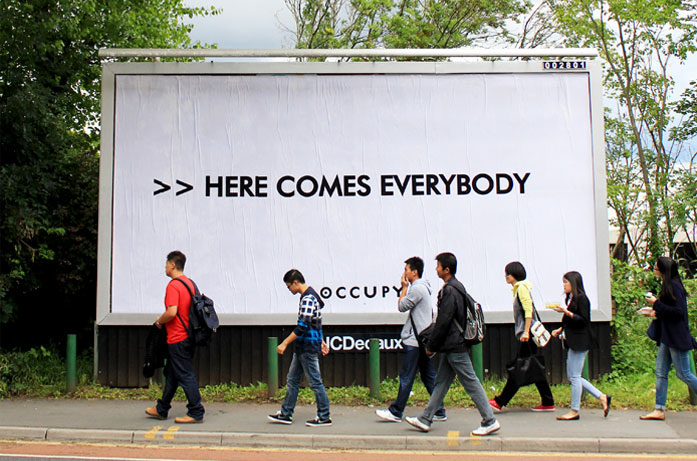
The Brandalism project started in 2012, as an extension of the guerilla art traditions of the 20th Century. A manifestation of various elements influenced by Agitprop; the Situationists; Graffiti and RA movements. We began by merging the arts, the politics and the social into the UK’s largest unauthorised exhibition by taking over 36 billboards in 5 UK cities. Internationally recognised artists were involved but on the street you wouldn’t know it as all the works were unsigned, and anonymously installed within public space as gifts to society as we attempted to connect individual forms of expression with collective bigger-than-self issues. It was part propaganda, part art. Popaganda as Ron English calls it. They were installed in and subverted spaces traditionally associated with commodity exchange and therefore could not be commercialised. The artworks spoke of something else. It was a threat and as a result, saw the national mobilisation of the big 3 outdoor advertisers (JCDecaux, ClearChannel and Primesight) to hunt down our art works and remove them from public space.
It is important to consider here that the spaces reclaimed by artists were in public space – the public sphere, although privately owned and operated by multinational advertising corporations. These spaces, in different sized formats number the 100s of thousands across the UK and we do not have the right as to whether we want to be saturated from up high by their messages (their screams) and their branded advertisements (their piss). This is a fundamental difference to the other forms of advertising that we come into contact with and have (to some extent) agency over. We can choose to turn a page, a channel or install software on our computers to remove these trespassers in our visual realm. We have no such luxury concerning public space. Which begs the question, why?
The consumeristic drive that infiltrated society saw citizens become more concerned about consumption than political actions. Furthermore, the growth of capitalistic economy led to an uneven distribution of wealth, thus widening economic polarity. Suddenly the media (and the art created by designers) became a tool of political forces and a medium for advertising rather than the medium from which the public got their information on political matters. This resulted in limiting access to the public sphere and the political control of the public sphere was inevitable for the modern capitalistic forces to operate and thrive in the competitive economy.
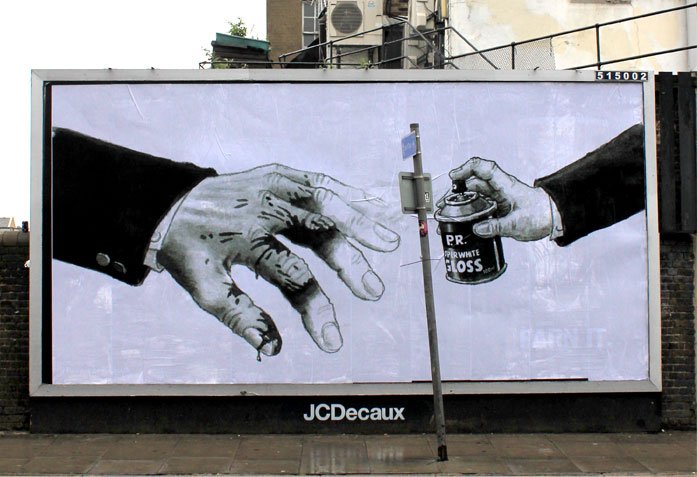
There with emerged a new sort of influence, i.e., media power, which, used for purposes of manipulation, once and for all took care of the innocence of the principle of publicity. The public sphere, simultaneously restructured and dominated by the mass media, developed into an arena infiltrated by power in which, by means of topic selection and topical contributions, a battle is fought not only over influence but over the control of communication flows that affect behavior while their strategic intentions are kept hidden as much as possible.
This understanding of the public sphere forged the starting point of the Brandalism project. How could we, as creative people, help re-democratise public space to share alternative messages and meanings about the social and environmental injustices caused by consumerism and change their monopoly over message and meaning in public space.
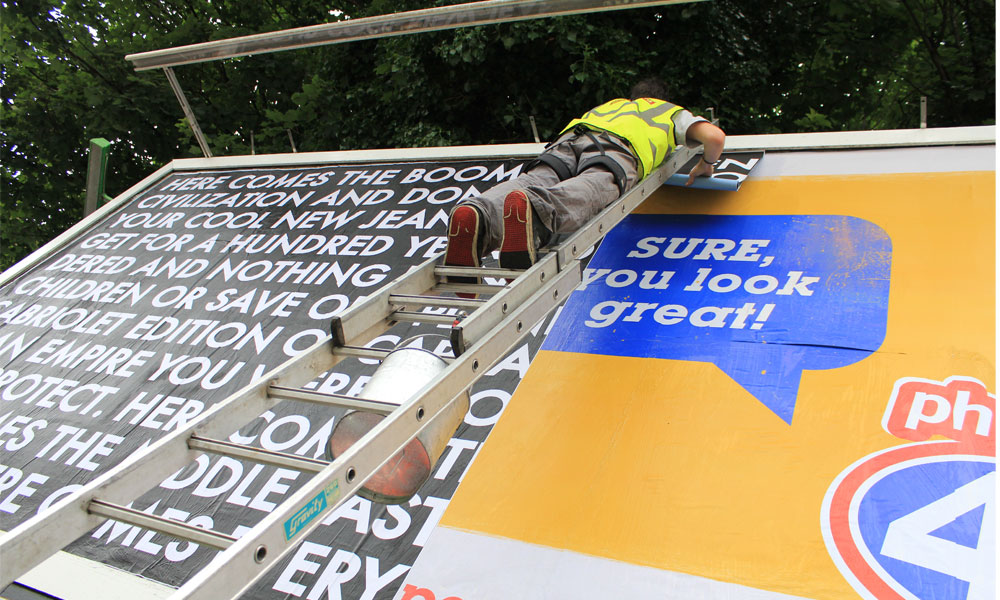
The idea behind Brandalism was to create new ideas and perceptions of public space at a time when it’s democracy is highly contested. In reflection, it fell short, as even though the project received international acclaim, striking cords of discontent across the world and new dialogues in various fields of thinking. In the end the fact remains that it was two pissed off people in a van intervening directly in public space, with the questions of privilege and power that the project wanted to engage with, still going fundamentally unanswered. What emerged in 2012 was clearly a temporary intervention, a starting point for further dialogue and development. It didn’t offer a solution to the problem of who gets the chance, opportunity and right to share messages and create meaning within public space / culture.
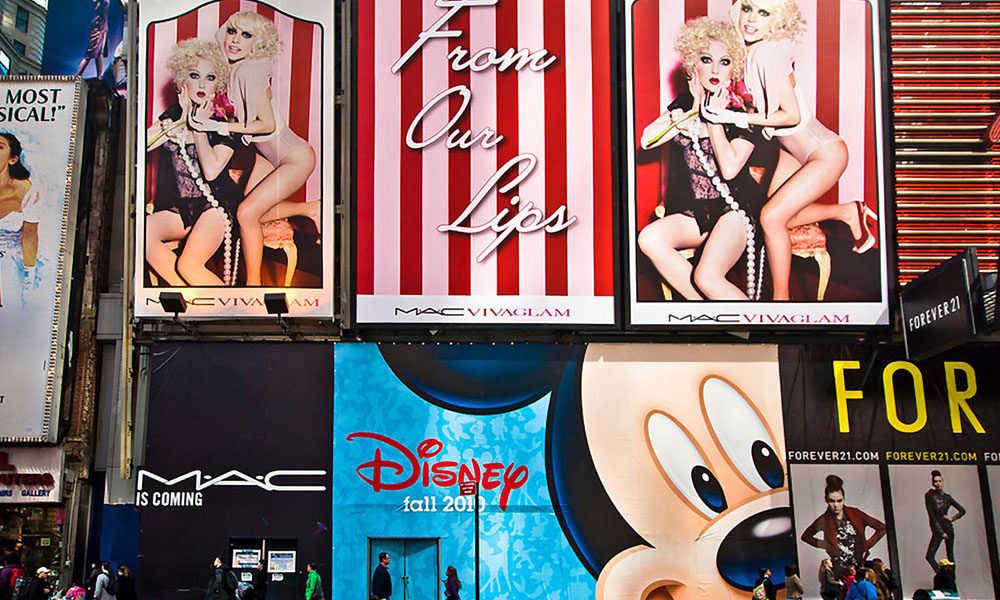
We have always seen culture as the spaces and places where society tells stories about itself. Every society has a space where these stories are told and in our culture it is advertising that dominates these spaces (both physical and digital). If we want to understand the messages that define (popular) culture then we have to look at the main storytellers. In our culture that is the storytellers that have the most money – the advertisers. Advertisers under-right and subsidise most forms of communication (print, radio, TV, Outdoor, Digital, Online) in the UK and their spending topped £14 billion in 2013 and with the digital outdoor sector showing growth rates of 17% in 2013, it isn’t about to slow down at any time soon. As a result of this pervasiveness, cognitive and social sciences (neuroscience, psychology and sociology in particular) note that studies tend to show that advertising distorts our most automatic behaviours, including unconscious behaviours (low attention processing model). With the emergence of technical explorations of the brain allowing us to better understand these mechanisms, we reveal that this new knowledge and its appropriation by the advertising industry (especially via neuromarketing) requires the widest possible debate and action on the presence of advertising in public space.
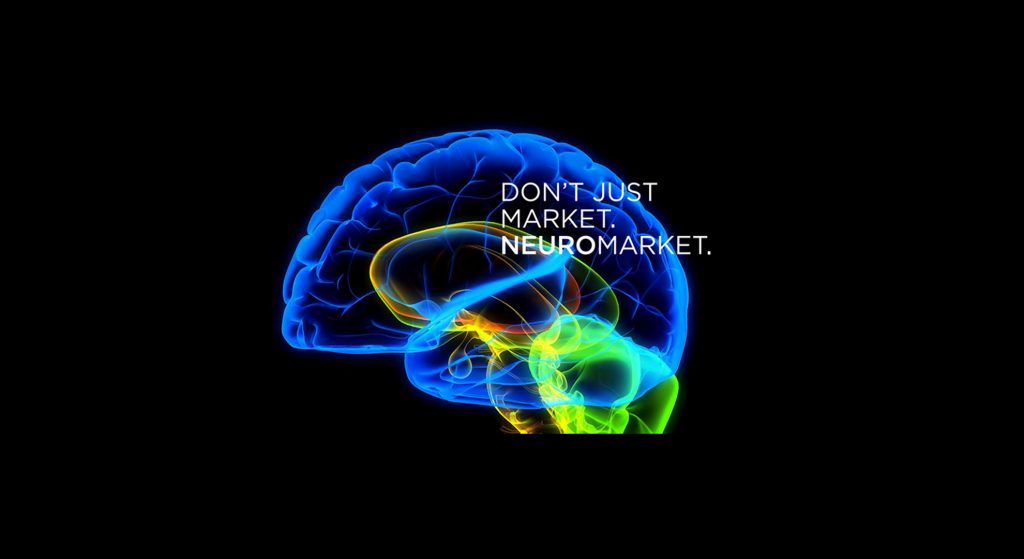
Using brain imaging, neuroscientists have recently begun to look at the effects of the branding of products on our brains. In this context, we focus on the reward system, a region of the brain that is evolutionarily very old. This system interacts with emotions and decision-making, it is highly sensitive to signals from our environment that can influence our behavior even when they are not consciously perceived. Targeting our reward system for advertising must also be considered in terms of public health. We know that the reward system is more vulnerable in some individuals. People suffering from obesity for example have their reward system abnormally activated by images of ultra-calorie food. Advertising exploits their vulnerability and strengthens their consumption behavior. Children with still developing nervous system are also very sensitive to advertising.
These studies are finally proving what many have suspected for decades that advertising affects and normalises attitudes, behaviours and values. Advertising doesn’t just reflect culture as the industry purports, it actively shapes our values and we have to resist our current reality where ‘the control of our culture remains with those who can afford it’ (Mclaren). Could we now say that the control of our collective values remains with those who can afford it?

If we want to understand our culture and society we had better come to terms with the role and power of commercial images. Consumerism does not stress the value of a collective long range future and the prevailing values of the commercial system provide no incentives to develop bonds with future generations. Faced with growing ecological and social crises, and with advertising being the engine of an unsustainable and detrimental economic system, we have to insist and manifest alternative values that will provide a humane, collective solution to these global crises. With so much of our culture focussed on consuming, to accept that you can’t make a mark on the world; that your only pleasure is to say “i bought”, never to say “i made” is a form of disempowerment that we need to reverse, quickly. We have to give them their shit back. And we are stronger together.
If we are to fundamentally alter this reality, we must begin from the understanding that we need to create in relation to capitalism, with rediscovered knowledge of our often forgotten, inherent abilities as creative humans; as cultural producers, not as the consumers we have been told we are from day.
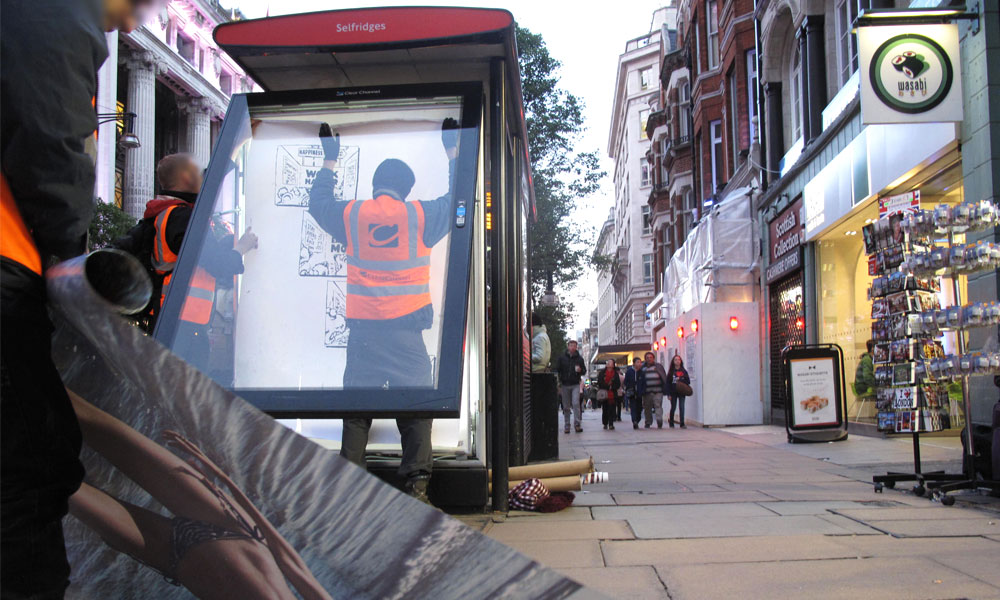
When the Brandalism project returned in 2014, we became fundamentally concerned with movement – we asked ourselves the question: what can we as a global network of citizens do together to challenge the cultural pessimism arising from the power of consumerism? How can we facilitate the reclamation of our right to the city and the unfinished project of the revolution of everyday life?
Across the globe the chasm between citizens and political institutions is growing and privatization of our public spaces is increasing. Neoliberal values ensure that the logic of the market dictates social relations via commodification. In response to this, a networked culture, a ‘movement of movements’, centered around global solidarity – a worldwide activism driven by citizens and spawned by globalisation, new media technologies and the expansion of art’s urban context has emerged in the last decade.
More people occupy urban centres than rural areas for the first time in world history. and if the city is both the producer of citizenship and the generator of innovation, it is the soil in which democracy lives. Without the city and maximized exchanges between inhabitants, democracy loses strength to create potential futures. The city is the past, present and future of democracy. Without a vision and constant activity to construct the city, we accept the slow, steady degradation of democracy.
There should be a guarantee for every citizen the right to choose where and when he/she wants to access advertising information. This is to enable citizens to protect their influence or simply to rest from information overload. According to estimates, in the UK we see on average 4000 brand impressions in the city, each day. Faced with this daily bombardment, the freedom of non-reception of citizens must be ensured, especially in public space. We as citizens must indeed be the guarantors of commercial neutrality as well as helping to provide psychological security for everyone. We don’t need anyone else to do it for us. We are the city. We are the streets.
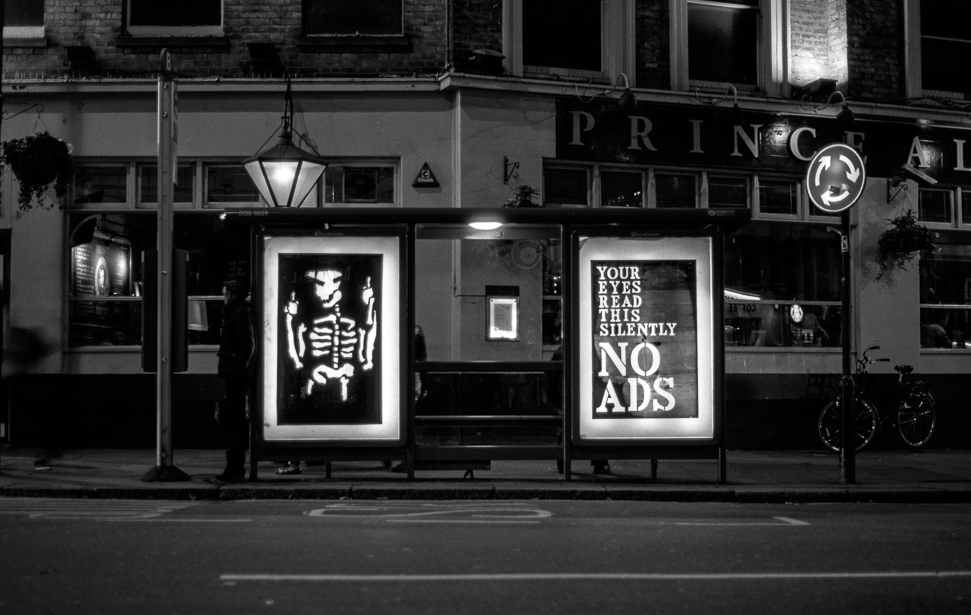
Re-democratising Public Space:
Brandalism’s recent attacks on the spaces of corporate advertising form part of this emerging movement in an attempt to shift artists’ and public attention to grass-roots activism as a means to combat the privatisation and corporate takeover of our cities, public spaces and culture. Public space is an arena in which no single authority should reign and multiple voices should be heard so we started from a profoundly democratic conviction that the public sphere is a place for communication, a place where people can speak, establish their presence, and assert their rights. By raising issues via art works, viewers could interpret and debate, Brandalism therefore attempts to wrest authority away from the wealthy and return it to the public, thereby defending the public as communal against the public as private. The public sphere should not be an arena of market relations but rather one of discursive relations, a theater for debating and deliberating rather than for buying and selling.
Our project saw a global network of artists transferring digital art works to us to print. We voted with consensus as to whether each art work should be included in what became the world’s largest unauthorised outdoor exhibition. On home made printing equipment 400 art works were collectively screen printed. Each one an original. Installed by teams in 10 major UK cities. We are now a network of citizens as artists, artists as citizens; with the true art being revealed and existing when the works were installed and observed in situ by participants. At once, privatized parts of public space became user-generated. Occupied spaces that are usually the preserve of powerful advertisers and political parties shared alternative messages, ideas and perceptions of what the public realm could be.
To build movement we now run workshops to facilitate other people how to intervene, to take back these spaces. We are planning for the next project with others from around the world. We are working together to position the citizen as narrator, and in the telling expound the thinking as well as the process to reveal to others how the city can become a playground, stage and instrument for unsanctioned artworks and activist interventions. This is the terrain of arts activism that re-democratises message, meaning and cultural forms of communication dominated by global, mass media corporations. We want to force them out of public space permanently. They do not have the right to our cities, our head space or our culture. We do. Reclaim your right to the city.
Bill Posters
2014
This text was originally published in STRIKE! Magazine here